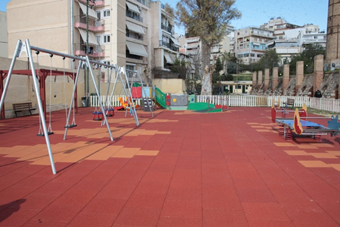Incivilities and security
The built environment plays an important role when it comes to security.
Incivilities are an example of this. They are also known as “signs of crime”, “early signs of danger”, “urban unease”, “broken windows”, “cues to danger”, “disorder”, or “prelude to trouble”.
These are low-level transgressions to rules of social life that signal the erosion of conventionally accepted norms and values, and they can manifest as:
-
disorderly physical surroundings (trash, litter, abandoned shops, graffiti, abandoned cars)
-
disruptive social behaviours (drinking, disorderly youths, loiterers, inconsiderate neighbours).
We can surmise that a first step towards improving security would be to remove these manifestations of disorder.
Among the various strategies that exist, beautification and target hardening were the ones that gain attention from the project partners in Piraeus.
Target hardening and beautification of schools and playgrounds
Target hardening refers to the strengthening of security around an object -such as a building- to deter or delay an attack, or reduce the risk of theft. In this case, it was achieved by installing fencing on the perimeter of the selected education facilities.
Beautifications refer to the need of improving the physical aspect of a space to impact in a positive manner the perception users have of it, and to prevent users from withdrawing from it. Spaces that are well-groomed and cared for tend to be safer.
We can say that these are two basic steps towards a more complex set of strategies in terms of urban transformations to improve security. These approaches were also suggested from the Local Council for Crime Prevention (LCCP, a structure that was also a product of the BSFS project) and the Division of Education of the Municipality.
There were manifestations of interest and support from the local community -namely, associations of parents and guardians- who expressed the need of improving security in schools. As a matter of fact, community members came forward to express the need of physical improvements in many schools in the zone.
Ultimately, three public high schools located in the 5th municipal district received an intervention. They were chosen due to the repeated incidents of vandalism and antisocial behaviour at night. Target hardening took the form of higher fencing and new entrance doors in the:
-
13th High School of Piraeus
-
3rd Senior High School of Piraeus
-
15th Senior High School of Piraeus
As for the second strategy -beautification-, schools were once again the main focus. The goal was to improve the image of vandalized schools in the 5th municipal district. Interventions took place in three schools. The beautification process took the form of repairing damaged coating, graffiti removal, new paint, and anti-graffiti paint.
-
3rd Senior High School of Piraeus (also intervened for target hardening).
-
6th Elementary & 1st kindergarten of Piraeus
-
4th High School of Piraeus

Lastly, we have the renovation of eight playgrounds in one of the most densely populated areas of Piraeus. This was one of the most important interventions of the BeSecure FeelSecure project.

These playgrounds are of small and medium size, with a high traffic of users had extensive damage to their equipment. These interventions had the support of the Mayor of Piraeus, as well as local authorities in the departments of Architecture, Public Health and Social Services, and European Projects. The process was kicked off with the intervention of Dilaveri Park, followed by seven more abandoned or vandalized playgrounds. The playgrounds were upgraded through:
-
safer installations (renovating pavement, new pieces of playground equipment),
-
better lighting, and
-
installation of natural fences.
About this resource
The Urban Innovative Actions (UIA) is a European Union initiative that provided funding to urban areas across Europe to test new and unproven solutions to urban challenges. The initiative had a total ERDF budget of €372 million for 2014-2020.
Similar content



